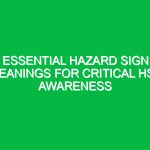Introduction
In the realm of workplace safety, understanding hazard signs and meanings is crucial. These signs serve as visual cues that communicate vital information about potential dangers, helping to prevent accidents and injuries. In the Health, Safety, and Environment (HSE) domain, hazard signs play a pivotal role in creating a safe working environment. This article delves into the various types of hazard signs, their meanings, and their significance in promoting workplace safety.
Understanding Hazard Signs
Hazard signs are symbols or images designed to convey specific information about hazards present in a work environment. They are an essential part of safety protocols, alerting employees and visitors to potential risks. In an age where workplace safety is paramount, knowing these signs can make a significant difference in preventing accidents.
The Importance of Hazard Signs in HSE
The primary purpose of hazard signs is to inform individuals about potential dangers. When individuals understand the meanings behind these signs, they can take appropriate precautions to protect themselves and others. Furthermore, effective communication of hazards through signs can significantly reduce the likelihood of workplace accidents.
Types of Hazard Signs
Hazard signs fall into several categories, each with distinct meanings. Here are the main types:
- Warning Signs: These signs indicate potential hazards that could result in injury or damage. They are often yellow with a black symbol. For example, a sign featuring a triangle with an exclamation mark warns of general hazards.
- Danger Signs: Typically red and white, danger signs communicate an immediate risk that could result in serious injury or death. An example is a sign depicting a skull and crossbones, which signifies toxic substances.
- Caution Signs: These signs are often yellow and indicate a lower level of risk. They advise individuals to proceed with caution, such as signs indicating wet floors or low ceilings.
- Mandatory Signs: These signs are blue and white, indicating actions that must be taken. For instance, a sign that states “Hard Hats Must Be Worn” instructs workers to wear protective gear.
- Prohibition Signs: Usually red with a diagonal line through a symbol, prohibition signs indicate actions that are not allowed. An example is a no smoking sign.
- Emergency Information Signs: These signs provide essential information during emergencies, such as exit routes or first aid stations. They are typically green and white.
Common Hazard Signs and Their Meanings
Understanding specific hazard signs and their meanings is vital for workplace safety. Here are some of the most commonly encountered hazard signs:
1. Biohazard Sign
The biohazard sign, often depicted as three interlocking circles, indicates the presence of biological substances that pose a threat to the health of living organisms. This sign is commonly found in laboratories or areas where infectious materials are handled.
2. Electrical Hazard Sign
This sign typically features a lightning bolt symbol and warns of potential electrical hazards. It serves as a reminder to handle electrical equipment with care to prevent electric shocks or fires.
3. Flammable Materials Sign
Represented by a flame symbol, this sign indicates the presence of flammable materials. It is crucial for preventing fires and ensuring that proper safety measures are followed in areas where such materials are stored or used.
4. Radiation Hazard Sign
The radiation hazard sign, often featuring a trefoil symbol, warns of the presence of radioactive materials. Understanding this sign is critical in environments such as hospitals or research facilities where radiation is used.
5. Slippery Surface Sign
Typically depicted with a person slipping, this sign warns individuals about wet or slippery surfaces. It is essential for preventing slip and fall accidents, particularly in areas prone to spills.
Best Practices for Hazard Signage
Implementing effective hazard signage is essential for ensuring workplace safety. Here are some best practices:
1. Clear Visibility
Ensure that hazard signs are clearly visible and easily understood. Signs should be placed at eye level and in locations where they are most relevant. Poor visibility can lead to accidents, as individuals may not be aware of potential dangers.
2. Regular Maintenance
Regularly inspect and maintain hazard signs to ensure they remain in good condition. Weather, wear and tear, or vandalism can damage signs, rendering them ineffective. Replace or repair any damaged signs promptly.
3. Training and Awareness
Conduct training sessions to educate employees about the meanings of hazard signs and the importance of following safety protocols. Awareness is key; when employees understand the risks associated with different hazards, they are more likely to take necessary precautions.
4. Incorporate Signage into Safety Protocols
Integrate hazard signage into your organization’s safety protocols. Ensure that all employees understand how to respond to the hazards indicated by the signs. This includes knowing when to use personal protective equipment (PPE) and when to evacuate the area.
5. Use Multiple Languages
In diverse workplaces, consider using multiple languages on hazard signs to ensure all employees can understand the warnings. This approach enhances safety by making information accessible to everyone.
Regulations and Standards Governing Hazard Signs
Understanding the regulations and standards that govern hazard signs is essential for compliance and safety. Various organizations set guidelines to ensure that signage is standardized and effective.
1. OSHA Standards
In the United States, the Occupational Safety and Health Administration (OSHA) sets forth standards for hazard communication, including signage requirements. OSHA mandates that employers provide clear and understandable warnings about hazards in the workplace.
2. ANSI Standards
The American National Standards Institute (ANSI) also provides guidelines for safety signage. ANSI Z535 provides a framework for designing safety signs, ensuring they are effective in conveying warnings and instructions.
3. International Standards
Globally, standards such as ISO 7010 outline the design and use of safety signs to ensure consistency and clarity across different regions. Adhering to these international standards can facilitate better understanding and compliance across borders.
Real-Life Examples of Hazard Sign Effectiveness
To illustrate the importance of hazard signs, consider the following hypothetical scenario:
In a manufacturing plant, a new employee was tasked with operating machinery in an area marked with a “Danger: Moving Parts” sign. Due to the clear warning, the employee took extra precautions, wearing protective gear and remaining vigilant. These measures kept the employee safe from potential injuries while operating the machinery.
Conversely, a case study from a construction site revealed a serious accident where workers ignored a “Caution: Overhead Load” sign. The failure to heed the warning led to a heavy object falling, resulting in injuries. This incident underscores the critical role that hazard signs play in preventing accidents.
Conclusion
In conclusion, understanding hazard signs and meanings is integral to workplace safety within the HSE context. By recognizing the various types of signs and their implications, individuals can take proactive measures to protect themselves and their coworkers. Implementing best practices for hazard signage and adhering to regulations can significantly reduce workplace incidents.
Safety is everyone’s responsibility, and being informed about hazard signs is a crucial step toward creating a safer work environment. Encourage your coworkers to familiarize themselves with these signs and promote a culture of safety in your workplace. Remember, awareness leads to action, and that action can save lives.


